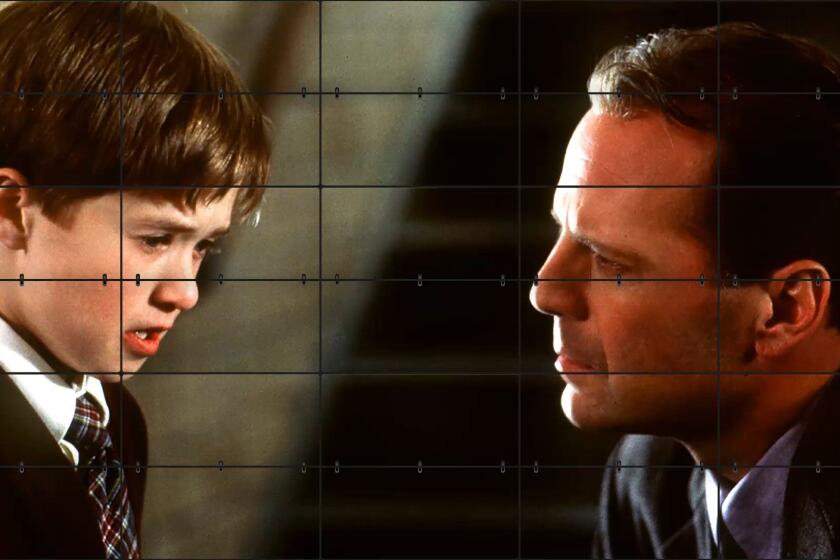Joe Grant, 96; Disney Artist Helped Make Films That Became Classics
Joe Grant, one of Walt Disney’s most talented artists and story men, whose career ran from the cartoon “Mickey’s Gala Premiere” (1933) to the Oscar-nominated short “Lorenzo” (2004), died Friday at his home in Glendale from a heart attack while at his drawing table. He was 96.
Grant, who was working at the Disney studio the day before his death, was not an animator but a story man -- an artist who helped develop the plot and dialogue of an animated film -- and a designer. He worked on numerous shorts, including “Gulliver Mickey” (1934) and “Who Killed Cock Robin” (1935). For “Snow White,” Disney’s first feature, Grant designed the Queen and the Wicked Witch.
During work on “Snow White” in 1933, Walt Disney came up to Grant in a hallway of the Hyperion studio in Loz Feliz and asked, “What are we going to do for an encore?” That question led to the establishment of the Character Model Department, which Grant headed with his vast knowledge of art, illustration and literature. It served as a research and development department for animated films and generated many of the ideas that became classic Disney films. The artists worked out ideas for stories and characters, and made model sheets and three-dimensional figures that showed how to draw the characters.
After working on “Pinocchio” (1940), Grant helped select the music for “Fantasia” (1940) and led the story development for that landmark film. With his creative partner, Dick Huemer, he wrote “Dumbo” (1941). During World War II, Grant contributed story ideas, gags and designs to war-related shorts, including “Reason and Emotion” (1943), “The New Spirit” (1942) and the Oscar-winning “Der Fuehrer’s Face” (1942).
When the Character Model Department disbanded in 1949, Grant left Disney to pursue other artistic ventures. He started several successful businesses, including a ceramics studio (Opechee Designs) and a greeting card company (Castle Ltd.).
“I think there was always a gentle sweetness to Joe and his work,” said Roy E. Disney, head of Disney Feature Animation from 1983 to 2004 and nephew of Walt Disney. “There’s a gentility in everything he touched. But there’s also a great sophistication. He was one of the truly great craftsmen of our art, but he always saw his craft as a way to communicate ideas.”
Forty years after he left Disney, Grant received a call from Disney’s Feature Animation Department, inviting him to consult on “Beauty and the Beast” (1991). Grant was soon working at the studio full time, with a new generation of artists, contributing ideas to “Aladdin” (1992), “The Lion King” (1994), “Pocahontas” (1995) and “Hercules” (1997).
For “Fantasia/2000,” Grant came up with the idea of flamingos with yo-yos for the “Carnival of the Animals” sequence, which Eric Goldberg animated and directed. In 1949, Grant began developing “Lorenzo,” a story about an obnoxious Persian cat whose tail comes to life. Working with Grant, director Mike Gabriel made “Lorenzo” into a film that received an Oscar nomination for Animated Short earlier this year.
Grant also contributed to Pixar Animation Studios features and coined the title for “Monsters, Inc.” (2001). “Monsters” director Peter Docter recalled, “Once when Joe and I were talking over some story concepts, he asked, ‘What are you giving the audience to take home?’ He meant, what part of the story will lodge in the audience’s heart, that they’ll remember for days or even years. I think about that every day, and I’ll be thinking about him and his advice for a long, long time.”
Grant was named a Disney Legend in 1992 and received the National Cartoonists Society’s Ruben Award in 1996. In 1998, he was honored at the animation festival in Annecy, France, and the Los Angeles Film Critics Assn. presented him with a special award for career achievement in 2002. More than 70 of his caricatures are included in the permanent collection of the Smithsonian Institution.
Born in New York City on May 15, 1908, Grant became interested in drawing while watching his father, an art director for William Randolph Hearst’s newspapers. In an interview in 2001, Grant recalled, “I was constantly looking over his shoulder -- and being attacked by other members of the family who insisted art was a futile pursuit. But I stuck it out, because I saw the magic of his hand on the drawing board.”
Grant came to Southern California as a boy. After attending the Chouinard Art Institute, he went to work as a caricaturist for the Los Angeles Record. Disney saw Grant’s print work and invited him to design the movie star caricatures in the cartoon “Mickey’s Gala Premiere.” After a few other freelance assignments, Disney invited Grant to work at the studio full time.
“I was at the point of syndication at that time, doing caricatures through the Chicago Tribune, and I was a little unhappy about giving that up,” Grant said. “But the idea of animation was overwhelming, the magic of it. I never lost sight of it. It was color, music, action -- what more could you want?”
Reflecting on his long career, Grant once told animation historian John Canemaker, “I’m interested not in what happened back then, but what we’re doing now and looking forward. Technology is running ahead of us right now. We’ve got to catch up with it with some good ideas.”
Grant is survived by two daughters, Carol Eve Grubb and Jennifer Grant Castrup; two grandchildren; and a great-grandson.
In lieu of flowers, the family suggests that donations be made to the Pasadena Humane Society and SPCA, 361 S. Raymond Ave., Pasadena, CA 91105
Funeral services will be held Saturday at the Church of the Recessional at Forest Lawn in Glendale.
More to Read
Only good movies
Get the Indie Focus newsletter, Mark Olsen's weekly guide to the world of cinema.
You may occasionally receive promotional content from the Los Angeles Times.










